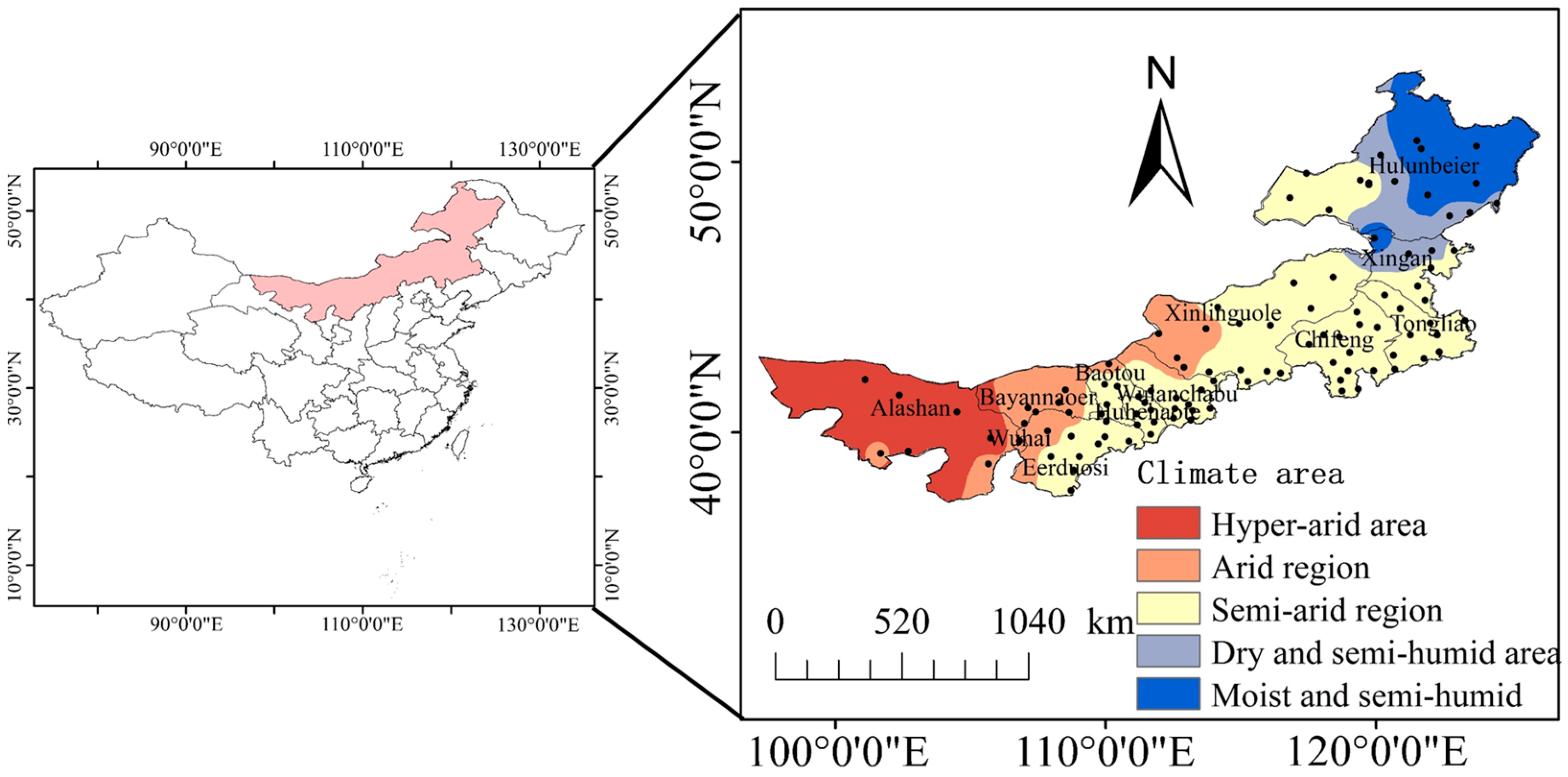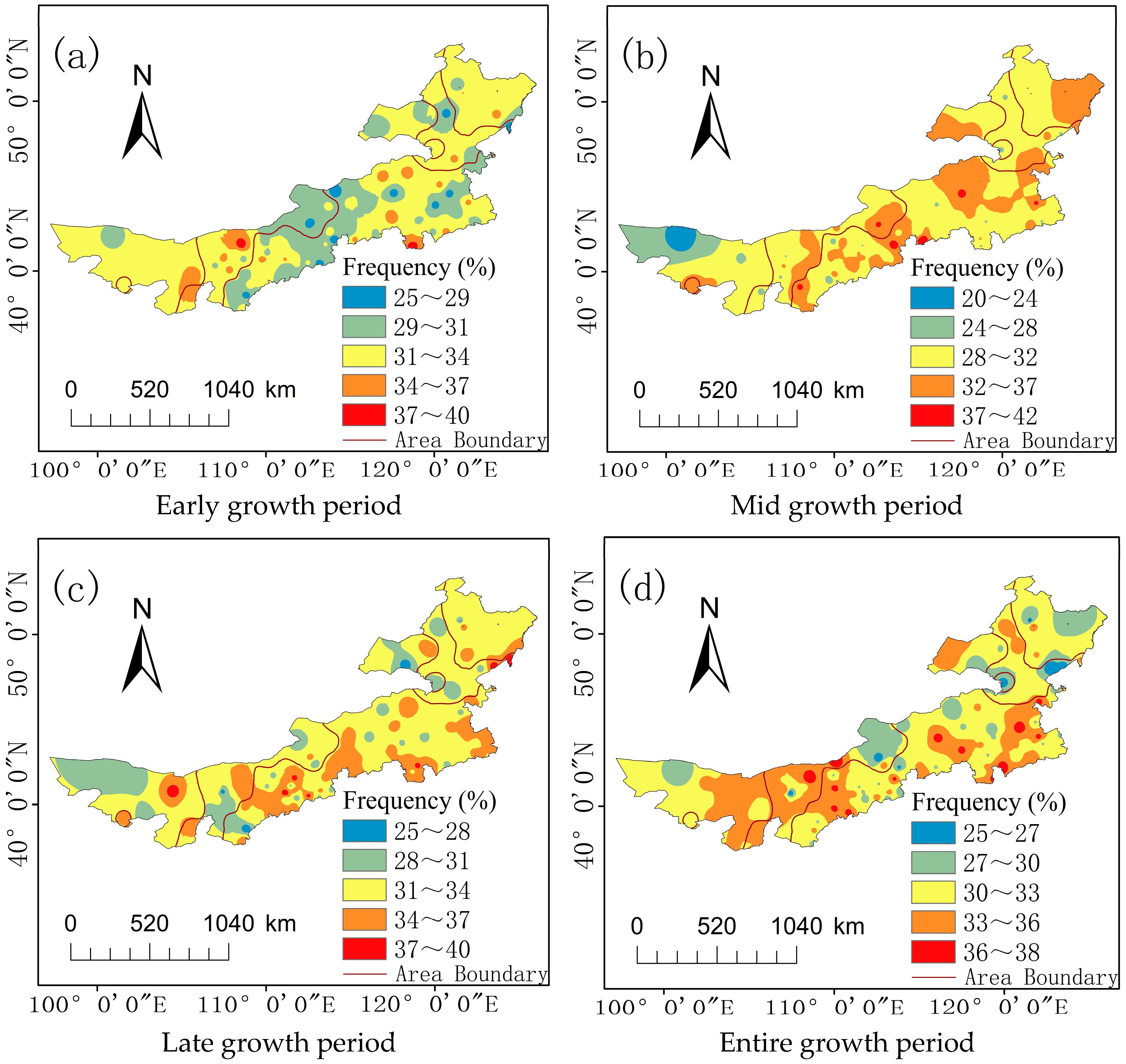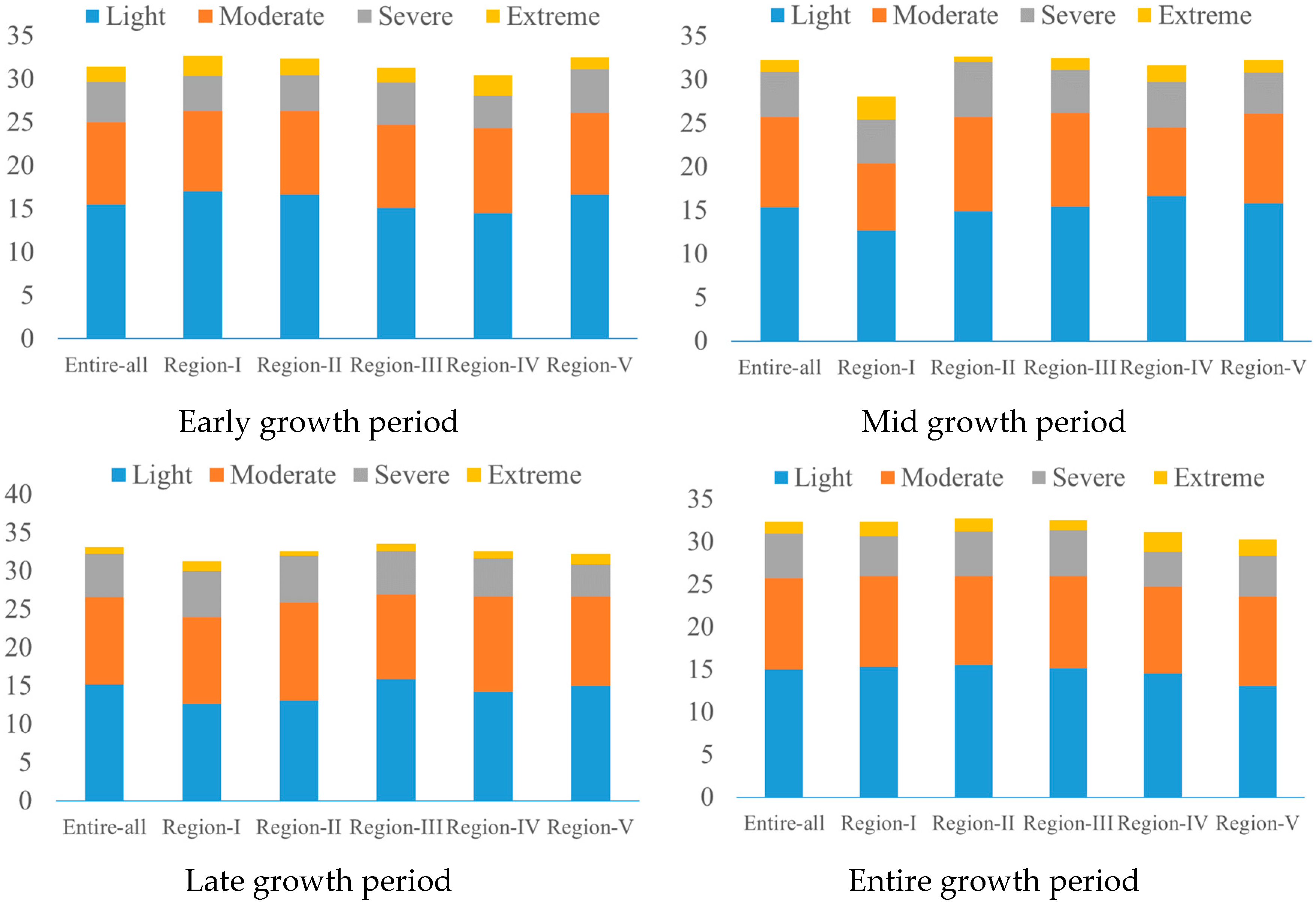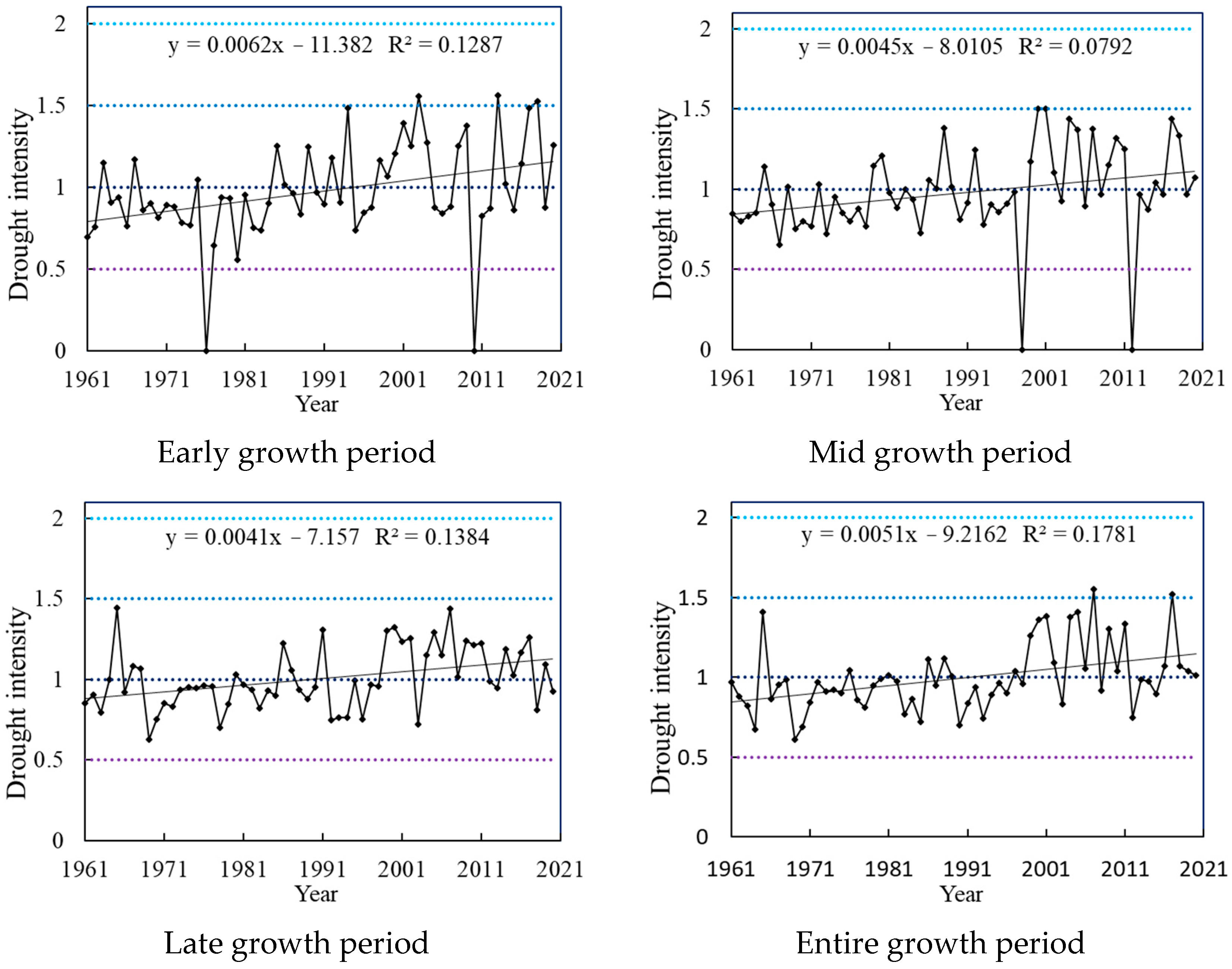Distribution Characteristics of Spring Maize Meteorological Drought in Different Climatic Regions of Inner Mongolia Based on Standardized Precipitation Evapotranspiration Index
Abstract
1. Introduction
2. Materials and Methods
2.1. Study Area Overview
2.2. Data Sources and Processing
2.2.1. Meteorological Data
2.2.2. Standardized Precipitation Evapotranspiration Index (SPEI)
2.2.3. Frequency of Drought Occurrence
2.2.4. Scope of Drought Occurrence
2.2.5. Intensity of Drought Occurrence
3. Results
3.1. Characteristics of Drought Occurrence During the Growth Period of Spring Maize
Temporal Variation Characteristics of SPEI During the Growth Period of Spring Maize
3.2. Frequency of Drought Occurrence During the Growth Period of Spring Maize
3.3. Scope of Drought Occurrence
3.4. Intensity of Drought Occurrence
3.5. Relationship Between Yield and Drought Conditions
4. Discussion
5. Conclusions
- (1)
- During the growing season, the climate tendency rates of the SPEI values across different climate regions and at various time scales were negative, indicating a trend towards aridification. Region I exhibited the most severe aridification trend, whereas Region V showed the mildest. Regarding spatial distribution, a few stations showed drought mitigation; however, most indicated intensifying drought trends.
- (2)
- Significant spatial differences in drought frequency were observed across spring maize growth stages. Areas with higher drought frequencies in the early, mid-, and late growth periods were concentrated in Regions I, II, and III, respectively. Throughout the reproductive period, drought frequency was generally higher in the entire region, Regions I, II, and III, whereas it was generally lower in Regions IV and V. The drought frequency at different levels in various climatic regions was characterized by a higher occurrence of mild and moderate drought, the lowest occurrence of extreme drought, and a moderate occurrence of severe drought.
- (3)
- The drought scope and intensity of spring maize showed an increasing trend in various growth stages, with larger increases occurring in the early growth stage. In the climatic regions, Region III experienced a relatively large drought scope during all growth stages, exceeding 76%. Drought intensity during each growth stage was predominantly mild to moderate, with severe droughts occurring infrequently, primarily during the initial growth stage and across the entire growth period. The main factors affecting spring corn yield are rainfall, wind speed, and drought conditions. The deployment of water-saving facilities and the selection of drought-tolerant varieties will be the main measures adopted in this region to address meteorological droughts. This study can provide a basis for developing drought resistance strategies in different climate regions.
Author Contributions
Funding
Data Availability Statement
Conflicts of Interest
References
- Ara Begum, R.; Lempert, E.; Ali, E.; Benjaminsen, T.A.; Bernauer, T.; Cramer, W.; Cui, X.; Mach, K.; Nagy, G.; Stenseth, N.C.; et al. Point of Departure and Key Concepts (Chapter 1). In IPCC 2022: Climate Change 2022: Impacts, Adaptation and Vulnerability. Contribution of Working Group II to the Sixth Assessment Report of the Intergovernmental Panel on Climate Change; Pörtner, H.-O., Roberts, D.C., Tignor, M., Poloczanska, E.S., Mintenbeck, K., Alegría, A., Craig, M., Langsdorf, S., Löschke, S., Möller, V., et al., Eds.; Cambridge University Press: Cambridge, UK; New York, NY, USA, 2022; pp. 121–196. [Google Scholar]
- Duan, W.L.; Takara, K.T. Extreme precipitation events, floods, and associated socio-economic damages in China in recent decades. In Impacts of Climate and Human Activities on Water Resources and Quality; Springer: Singapore, 2020; pp. 11–29. [Google Scholar]
- Yu, C.; Huang, X.; Chen, H.; Huang, G.; Ni, S.; Wright, J.S.; Hall, J.; Ciais, P.; Zhang, J.; Xiao, Y.; et al. Assessing the impacts of extreme agricultural droughts in China under climate and socioeconomic changes. Earth’s Future 2018, 6, 689–703. [Google Scholar]
- Zhou, Z.G.; He, L.J.; Zhong, Y.; Wang, L.C.; Qin, W.M.; Zhang, X. Evaluation and analysis of MODIS and VIIRS satellite aerosol optical depth products over China. China Environ. Sci. 2024, 44, 4211–4229. [Google Scholar]
- Wang, M.H.; Jiang, S.H.; Ren, L.L.; Cui, H.; Ren, M.M. Evaluation of flash drought under the impact of heat waves events in the Weihe River Basin. Water Resour. Dev. Res. 2023, 23, 21–28. [Google Scholar]
- Li, G.Y. Thoroughly implement the spirit of the 20th National Congress of the Communist Party of China and solidly promote the high-quality development of water conservancy in the new stage—Speech at the National Water Conservancy Work Conference in 2023. Water Resour. Dev. Res. 2023, 23, 1–11. [Google Scholar]
- Dai, H.Y.; Li, D.; Su, R.N.; Chen, S.H.; Du, W.L. Dry and wet environment evolution and climatic background analysis of regional ecological construction in Inner Mongolia. Arid. Land. Geogr. 2019, 42, 745–752. [Google Scholar]
- Yu, L.L.; Tang, S.N.; Chen, F.; Ding, Y.Y.; Yang, Y.Z. Analysis of the development and utilization of water resources in Inner Mongolia autonomous region and countermeasures. Water Resour. Plan. Des. 2019, 16–19+43. [Google Scholar]
- Qiao, S.S.; Gao, X.Y.; Qu, Z.Y.; Yang, X.J.; Chang, X.; Yang, F.; Feng, X.W. Impact of climate change on the water requirements and yield of spring maize in Inner Mongolia of China from 1959 to 2018. Agric. Water Manag. 2022, 38, 87–97. [Google Scholar]
- Chen, J.; Zhou, L.; Yu, M.W. Ecological environmental problems and suggestion of scientific exploitation and utilization of groundwater resource in the west of liaohe plain inner Mongolia. Hydrogeol. Eng. Geol. 2008, 35, 123–125. [Google Scholar]
- Xing, Z.X.; Li, G.; Fu, Q.; Wang, J.Q.; Duan, W.Y.; Wang, H.L.; Liu, H.Q. Construction of an optimized comprehensive drought index for agricultural watersheds in cold regions and its applicability analysis. Water Resour. Prot. 2023, 39, 42–51+78. [Google Scholar]
- Song, Y.L. Global research progress of drought indices. J. Appl. Meteorol. Sci. 2022, 33, 513–526. [Google Scholar]
- Li, W.G.; Liu, S.J.; Hou, M.T.; Han, J.; Chen, X.M. Advance in the study on meteorological and agricultural drought indices. Meteorol. Environ. Sci. 2021, 44, 76–82. [Google Scholar]
- Su, X.L.; Zhang, G.X.; Feng, K. Progress and perspective of drought index. J. Water Resour. Archit. Eng. 2019, 17, 9–18. [Google Scholar]
- Yao, N.; Jiang, K.H.; Xie, W.X.; Zhang, D.Y.; Yang, X.J.; Yu, Q. Temporal and spatial evolution of drought disasters in Shanxi province under background of climate change. Trans. Chin. Soc. Agric. Machin. 2024, 55, 270–281. [Google Scholar]
- Wei, J.; Ma, Z. Comparison of palmer drought severity index, percentage of precipitation anomaly and surface humid index. Acta Geogr. Sin. 2003, 58, 117–124. [Google Scholar]
- Palmer, W.C. Meteorological Drought; US Department of Commerce, Weather Bureau: Washington, DC, USA, 1965.
- Zhao, Z.Z.; Zhang, B.L.; Pan, L.J.; Niu, P.T.; Guo, J.P. Drought diagnosis and prediction using SPEI in eastern Inner Mongolia. Environ. Ecol. 2023, 5, 39–48. [Google Scholar]
- Xie, M.; Gao, J.L.; Sun, J.Y.; Yu, X.F.; Wang, Z.G.; Hu, S.P.; Zhang, L. Spatiotemporal variation of drought in Inner Mongolia estimated based on the standardized precipitation evapotranspiration index. J. Irrig. Drain. 2022, 41, 140–146. [Google Scholar]
- Li, H.Y.; Ma, L.; Liu, T.X.; Du, Y.X.; Liu, M. Change and relationship of temperature and precipitation in Inner Mongolia during 1951–2014. J. Glaciol. Geocryol. 2017, 39, 1098–1112. [Google Scholar]
- Zhang, X.T.; Pan, X.B.; Xu, L.; Wei, P.; Yin, Z.W.; Shao, C.X. Analysis of spatio-temporal distribution of drought characteristics based on SPEI in Inner Mongolia during 1960–2015. Trans. Chin. Soc. Agric. Eng. 2017, 33, 190–199. [Google Scholar]
- Yang, X.J.; Sun, J.Y.; Gao, J.L.; Qiao, S.S.; Zhang, B.L.; Bao, H.Z.; Feng, X.W.; Wang, S.Y. Effects of climate change on cultivation patterns and climate suitability of spring maize in Inner Mongolia. Sustainability 2021, 13, 8072. [Google Scholar] [CrossRef]
- Middleton, N.; Thomas, D. World Atlas of Desertification, 2nd ed.; Arnold, Hodder Headline, PLC: London, UK, 1997. [Google Scholar]
- Begueria-Portugues, S.; Vicente-Serrano, S.M.; Angulo-Martínez, M.; López-Moreno, J.I.; El Kenawy, A. The standardized precipitation-evapotranspiration index (SPEI): A multiscalar drought index. In Proceedings of the 10th EMS Annual Meeting, Zürich, Switzerland, 13–17 September 2010. [Google Scholar]
- Yu, L.H.; Xie, W.S.; Xiong, S.W.; Zhang, X.T.; Xing, C.; Hu, S.S. Characteristics of drought and flood based on SPEI and its impact on wheat yield in Chuzhou of Anhui province. J. Arid. Meteorol. 2021, 39, 742–749. [Google Scholar]
- Tong, S.Q. Spatio-Temporal Variations and Prediction of Meteorological Drought in Inner Mongolia Under Climate Change; Northeast Normal University: Changchun, China, 2019. [Google Scholar]
- Qu, M.L. Guidance for Agricultural Climate Internship; Beijing Agricultural University Press: Beijing, China, 1991. [Google Scholar]
- Güçlü, Y.S. Multiple Şen-innovative trend analyses and partial Mann-Kendall test. J. Hydrol. 2018, 566, 685–704. [Google Scholar] [CrossRef]
- Guo, X.M.; Tong, S.Q.; Bao, Y.H.; Ren, J.Y. Spatial and temporal variation trend analysis of drought in Inner Mongolia in the past 55 years based on SPEI. Geomat. World 2021, 28, 42–48+79. [Google Scholar]
- Zhao, S.X.; Zhou, Q.C.; Wang, W.J.; Wu, Y.J. Dry-wet climate characteristics of Inner Mongolia based on standardized precipi tation index. J. China Inst. Water Resour. Hydropower Res. 2022, 20, 10–19. [Google Scholar]
- Wu, Y.J.; Li, W.; Wang, W.; Quan, Q.; Chen, X.J.; Yin, H.; Zhou, Q.C.; Xu, K.R. Drought characteristics in Inner Mongolia based on precipitation anomaly percentage. Arid Zone Res. 2019, 36, 943–952. [Google Scholar]
- Na, Y.T. Drought characteristics in Inner Mongolia based on the SPI index in the last 50 years. J. Arid. Land Resour. Environ. 2015, 29, 161–166. [Google Scholar]
- Zhu, M.Y.; Zhang, H.; Li, S.; Zhang, B.B.; Chang, S.; Cai fu Zhao, J.; Cai, W.B. Effects of water stress and supplement after sowing on emergence rates of maize. J. Meteorol. Environ. 2019, 35, 101–107. [Google Scholar]
- Han, Z.H.; Liu, X.G.; Hao, K.; Yu, N.; Liu, Y.W.; Yang, Q.L. Drought evolution characteristics and trend prediction in Inner Mongolia based on standardized precipitation index. J. Drain. Irrig. Machin. Eng. 2017, 35, 430–439. [Google Scholar]
- Sun, B.L.; Ma, L.; Feng, Q.; Liu, T.X.; Liang, L.T.; Li, H.Y.; Zhou, Y.; Liu, Y. Response of the warming hiatus to changing influences over the Inner Mongolia autonomous region. China Environ. Sci. 2019, 39, 2131–2142. [Google Scholar]
- Ma, Z.C.; Yu, H.B.; Zhang, Q.F.; Cao, C.M. Characteristics and sudden changes of temperature and precipitation in Inner Mongolia from 1960 to 2016. Res. Soil Water Conserv. 2019, 26, 114–121. [Google Scholar]
- Zhang, Q.F.; Yu, H.B.; Huang, F. The spatiotemporal dynamics of drought and the cumulative impact on vegetation phenology in the Mongolian Plateau. Arid Zone Res. 2024, 41, 1548–1559. [Google Scholar]










| Drought Level | Type | Classification Criteria (SPEI) |
|---|---|---|
| 1 | Normal year | (−0.5, +∞) |
| 2 | Light drought | (−1.0, −0.5] |
| 3 | Moderate drought | (−1.5, −1.0] |
| 4 | Severe drought | (−2.0, −1.5] |
| 5 | Extreme drought | (−∞, −2.0] |
| Intensity Level | Extreme Drought | Severe Drought | Moderate Drought | Light Drought | Normal Year |
|---|---|---|---|---|---|
| Sij | Sij ≥ 2 | 1.5 ≤ Sij < 2 | 1 ≤ Sij < 1.5 | 0.5 ≤ Sij < 1 | Sij < 0.5 |
| Climate Region | Typical Region | Regression Model | R2 | p |
|---|---|---|---|---|
| Hyper-arid region | Alxa | y = 7605.009 − 1860.153Win4 − 12.116 Pe2 | 0.318 | <0.05 |
| Arid region | Bayannur | 6847.723 − 1236.317Win2 − 324.377D1 + 220.762 Ssd2 | 0.405 | <0.05 |
| Semi-arid region | Ordos | y = 1169.503 − 34.179 Rhu1 | 0.292 | <0.05 |
| Baotou | y = 309.77 − 8.435 Pe1 | 0.246 | <0.05 | |
| Hohhot | y = −606.307 + 3.375 Pe2 | 0.362 | <0.05 | |
| Chifeng | y = −7764.131 + 7.410 Pe2 + 231.110D2 | 0.518 | <0.05 | |
| Dry and semi-humid region, moist and semi-humid region | Hulunbeier | y = −6992.304 + 20.069 Pe1 + 673.601 Ssd1 | 0.409 | <0.05 |
Disclaimer/Publisher’s Note: The statements, opinions and data contained in all publications are solely those of the individual author(s) and contributor(s) and not of MDPI and/or the editor(s). MDPI and/or the editor(s) disclaim responsibility for any injury to people or property resulting from any ideas, methods, instructions or products referred to in the content. |
© 2025 by the authors. Licensee MDPI, Basel, Switzerland. This article is an open access article distributed under the terms and conditions of the Creative Commons Attribution (CC BY) license (https://creativecommons.org/licenses/by/4.0/).
Share and Cite
Yang, X.; Qiao, S.; Yang, F.; Huang, Y.; Han, C.; Chang, X.; Hao, S.; Qian, H.; Feng, X.; Li, N. Distribution Characteristics of Spring Maize Meteorological Drought in Different Climatic Regions of Inner Mongolia Based on Standardized Precipitation Evapotranspiration Index. Water 2025, 17, 938. https://doi.org/10.3390/w17070938
Yang X, Qiao S, Yang F, Huang Y, Han C, Chang X, Hao S, Qian H, Feng X, Li N. Distribution Characteristics of Spring Maize Meteorological Drought in Different Climatic Regions of Inner Mongolia Based on Standardized Precipitation Evapotranspiration Index. Water. 2025; 17(7):938. https://doi.org/10.3390/w17070938
Chicago/Turabian StyleYang, Xiujuan, Shuaishuai Qiao, Feng Yang, Yuyuan Huang, Congying Han, Xiao Chang, Shuiyuan Hao, Hui Qian, Xinwei Feng, and Na Li. 2025. "Distribution Characteristics of Spring Maize Meteorological Drought in Different Climatic Regions of Inner Mongolia Based on Standardized Precipitation Evapotranspiration Index" Water 17, no. 7: 938. https://doi.org/10.3390/w17070938
APA StyleYang, X., Qiao, S., Yang, F., Huang, Y., Han, C., Chang, X., Hao, S., Qian, H., Feng, X., & Li, N. (2025). Distribution Characteristics of Spring Maize Meteorological Drought in Different Climatic Regions of Inner Mongolia Based on Standardized Precipitation Evapotranspiration Index. Water, 17(7), 938. https://doi.org/10.3390/w17070938





